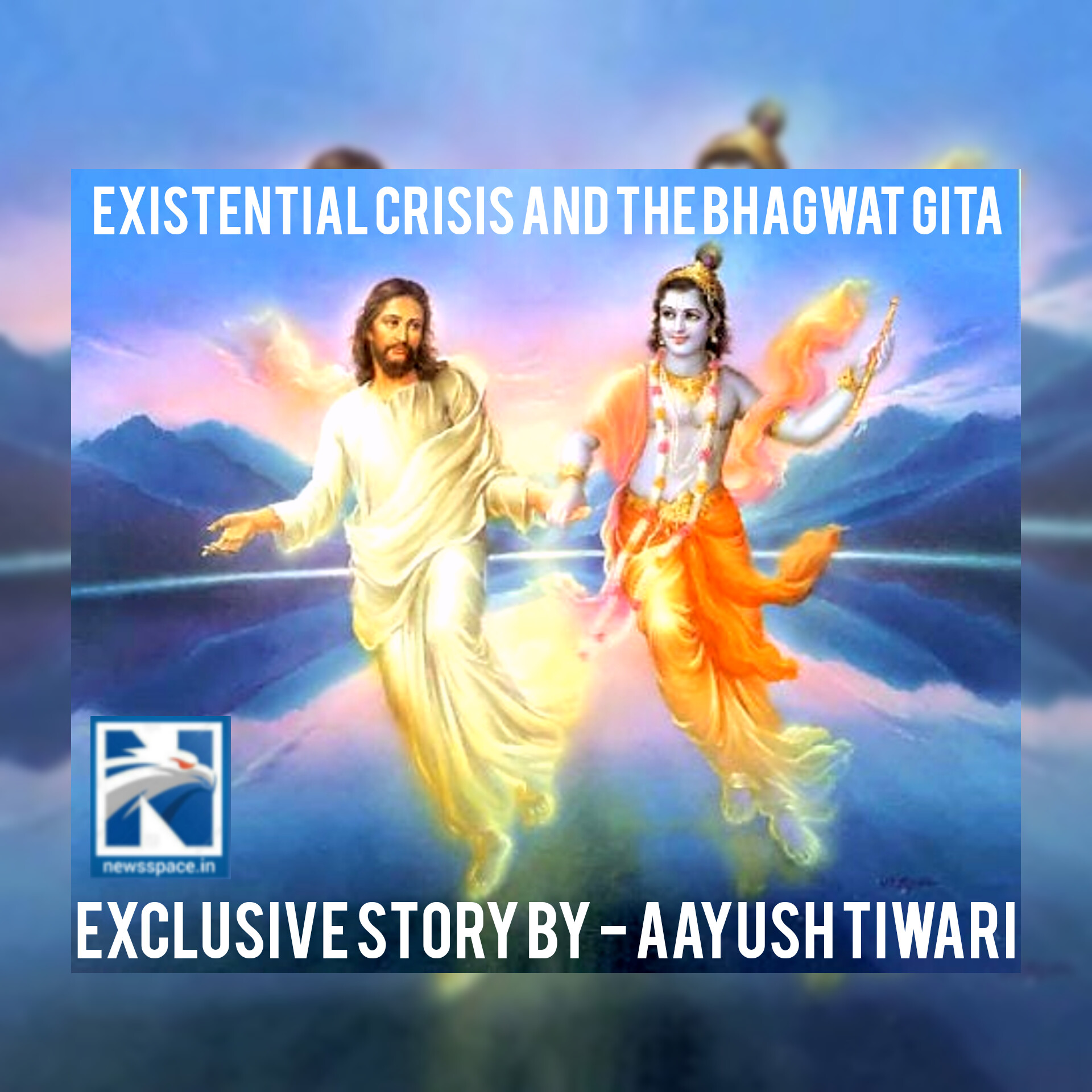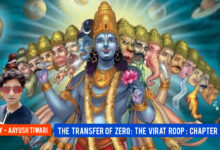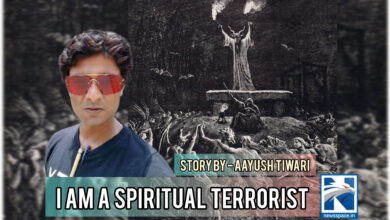
Aayush Tiwari –
Existential Crisis and The Bhagwat Gita
Bhagwat Gita is a conversation that is not happening under the shade of a tree with some saint lecturing on the Dos and don’ts of life. It is in fact the profoundest psychoanalysis that is happening amidst the battlefield of Kurukshetra with both the armies lined up to bath in each other’s blood the very next moment. Every verse in this magnum opus has a scientific explanation and perhaps that’s why it is so much revered in the scientific community. Considering the impossibility of explaining the rationale behind each and every verse first we must come to the ‘assentio-mentium’ why Krishna should be trusted at all?
Krishna has warned Arjun that this wisdom of Bhagwad Gita is not to be shared with every Tom, Dick and Harry as if a person devoid of faith zaps through it, Krishna might look as if bragging of his omnipotence. Well, to substantiate it I cite another example. If it is raised that whether Jesus was really the son of god or not, then I ask if he was not then who else can assert in such ineffable pain on the cross “Forgive them father, they no not what they do.” The statement itself is enough to qualify the worth of the person. In a similar way if it is questioned whether Krishna is actually what he claims then it must be pondered that if not the god who else can shower such a wisdom that too in the battlefield. Krishna’s spectrum is infinite and infallible in every shade of life, his life is a Bhagwad Gita in itself. He had romanced, he had run away from battlefields(ranchor), he had been an invincible warrior, he had annihilated all his enemies and also had been a true friend. He despite capable of beheading Shishupal with at the first abuse word kept on smiling till the hundredth profane word and no sooner it proceeded to the hundred and one, shot the abuser point blank on the head. In every possible context one can think of, Krishna has reflected the best possible conduct that could be possible. It is also to rapt that that the armies there at the battlefield were not waiting for Krishna and Arjuna for those 700 verses to be completed and therefore it is to be inferred that the Bhagwad Gita was teleported to Arjuna beyond space and time in consonance with the quantum entanglement theory of the Quantum mechanics.
There are 18 chapters in the Gita enlightening various enigmas like karma, beyond life-death phenomenon, time dilation, liberation, yoga, meditation, moksha, devotion, science, psychology, and even the time travel. But if I am asked about the most significant chapter of the book I would say it is not one coming from the god rather it is from the devotee; the first chapter also known as Arjuna’s vishad-yoga or Arjun-shodh yoga.
In the first chapter a contrast is set with Arjuna’s depression and his probe on life with a sick state of mind (Arjun shodh[research] yog). He by the virtue of being a herculean warrior knows very well that enduring injustice is as much of a crime as committing it but on the other hand his foresight on futility in regaining his empire at the cost of such bloodshed takes the confluence of Nar and Narayana to the existential domain. Arjuna is clear that the pleasure attached with materialism is like a mirage and causing such massacre for a virtual reality is not justifiable. Krishna on the other hand reflects that quality that our generation is missing miserably. The patience to listen. He just listens Arjuna speak throughout the first phase and refrains from any reaction other than his serine smile. It is also to be noted here that as one imbibes Bhagwad Gita in its veracity it becomes apparent that the conversation is not confined to that particular battle. Born into this world Bible says we are born in sin and hence everyone here is somehow standing on the battlefield either for survival or for self-realization.
The existential crisis is deeply centered in the concept of death the way homo sapiens perceive it. This realization that we are walking dead with a few years of so called life span deceiving us in this numerous cosmic time scale. As the seeker realizes that no matter what we earn lying, cheating, stealing, toiling, laboring the death takes away everything without exception then such realization is leads to the existential crisis. In consonance with the law of conservation of energy (that says energy can neither be created nor destroyed, it just changes its forms) Krishna addresses this dilemma of death saying that the soul is a form of energy (the pranmayakosha and the vigyanmayakosha) that can neither be created or destroyed rather just changes its form from one physical body(anamayakosha) to the other.
The best thing about the Bhagwad Gita is that it annihilates psychological fear of death at war level. “Vasansi jinarni yatha vihai, navani grehati naro parani. Tatha sharirani vihai jirana nayanani sayanti navani dehi” (Just like a person changes his or her cloths from old to new the soul or the ‘atman’ changes the physical body changes from old to new; as the next life)
He blatantly points out our association confined to the destructible physical body and mental body as sheer ignorance in chapter 2 verse 7; “Ya ainam hantaram manyata hatam, ubhou tau na vijanito nayam hanyati na hanyate.” He further elaborates exquisitely the soul to be unfazed by penetrating weapons and burning fire as “Nainam chidanti shastrani nainam dahati pavakah.” (Chapter2, verse 23).
As we dig deep we realize that during death the mental body(manomayakosha) and the physical body(anamayakosha) fall apart but the subtler dimensions of a comprehensive human body, the energy body (pranamayakosha) and the etheric body(vigyanmayakosha) remain intact and are carried forward through the next physical bodies. This inertia of motion of the energy body and the etheric body are helpful to explain the concepts of reincarnation and the karmic structure one carries through the next life in the light of previous life. Although the world today is plagued by various notions related to them but the Bhagwad Gita in its purest form explains the notion quite clearly that may be a great relief against the very molecular nature of the existential crisis. As mentioned earlier Neils Bohr once quoted that if a person is not left dumbfounded reading the Quantum Mechanics then it implies he has yet not understood it, it’s the farsightedness of the God that he knew very well that such notions cannot be conceived by a human mind directly so he explains further that someone looks up at the soul with wonder, someone with curiosity, someone explains it with wonder but still for the most it is remains incredible. Chapter 2, Verse 29 “Ascharya vatvpashyati kacchitchdenm ascharya vadyati tathaiv chanyahaah , ascharya vachnamanya churonti chuvapyaen ved chaiv kachhitah “
An abstract explanation of the notion lies preserved in one of my poems written in the ashram deeply affected by the death of an ashram inmate.
Adam’s old hat
John and Adam were childhood friends
And to be true they were more than that
Like a child can’t live without his mother
Were they both without each other
Even if storm did rage lightening did fall
Insanely ran Adam whenever John called
And like a key is without a lock
Was our Adam without his John.
But ended that joy as World War did rage
Adam had to go for enemies to be faced.
Now solitary seemed village, John was alone
Where were they both, who seemed like clones.
Like a body devoid of sole
Were they both gloomy all alone
John was worried, John was agitated
How is my friend his eyes radiated
Though Adam wrote letter on and on
Your buddy is ok, don’t worry my John.
Years ticked by but hearts dint glow
Constantly the tears from John’s eye flow
Time did run letters did come
John kept on living with hope on them
But after the war he, his patience did loose
“I will find somehow my childhood dude’
He went for years looking for his friend
Forests he crossed rivers he swam.
His eyes were bleeding at peak was his hunger
As he finally found those smashed little bunkers
Near the bunker was Army’s pent house
As he opened the door, cobwebs he found.
Oh, hundreds of letters were scattered on shelf
With the future dates written on them
In tears our John then did burst
As he read those letters lying in dust
When asked by John it was told to him
Fake letters were posted as Adam’s last wish.
And then John noticed near the mat.
Stained with blood was Adam’s old hat.
Let us draw an analogy here. Suppose there are two people, person A and person b. A is sitting at the top of a fully grown Redwood tree while B is standing at its bottom. Now a car is coming towards the tree from a few miles. A can see the car coming from far because of that height but because of the hazy weather and the skyscrapers the car is yet invisible to B. Now after a few moments the car comes near the tree, as evident now both A and B can see it. In the third instance the car has now again moved far from the tree in the same direction. Now A can still see the car being at the top while it becomes invisible again to B. in a similar vein the height of consciousness at which Krishna is like the person A in our example. With that frame of reference Krishna says, “You were, you are and you will be.” Although for Arjuna the car is visible only for the moments the car was near the tree. We divide time in present past and future and for us the present is the duration till which we can witness the car. But for a person from the height of Krishna-consciousness the car of consciousness was there, it is there and it will be there.
As discussed, existential crisis is a byproduct of intelligence. As per Krishna, peeling through the layers of the intellect eventually realizing the nature of this evanescent world and consequently falling into a turmoil is a bane for an individual. Lucky are the people who indulge in this existential warfare as this is the crossroad from where a soul starts getting inclined towards the divine. He says out of a million some few fall into this line of thought and out of those few millions, a few manage to get through it. Still he persists to the fact that unless a seeker falls in the vicious trap of the this crisis the real quest for divintity remains out of the question. He expresses in Chapter two, Verse 32 that fortunate are the seekers who by default enter into the combat mode with the existential crisis “Yadwakchaya choppantram swarg dwar pavratam, sukhinah chatriya Partah labhante yuddhmedrasham.” He further explains that even non doing is a doing (Akarma is also a karma) and there is no escape for the mediocre who tend to evade this phase in life hence losing the divine grace as follows “Ath chetvamimam dhamyarya sangramam na karishyasi, tatah swadharmam ch hitwa papam vapasyasi.”
The Bhagwat Gita is a psychological end to the existential crisis.





